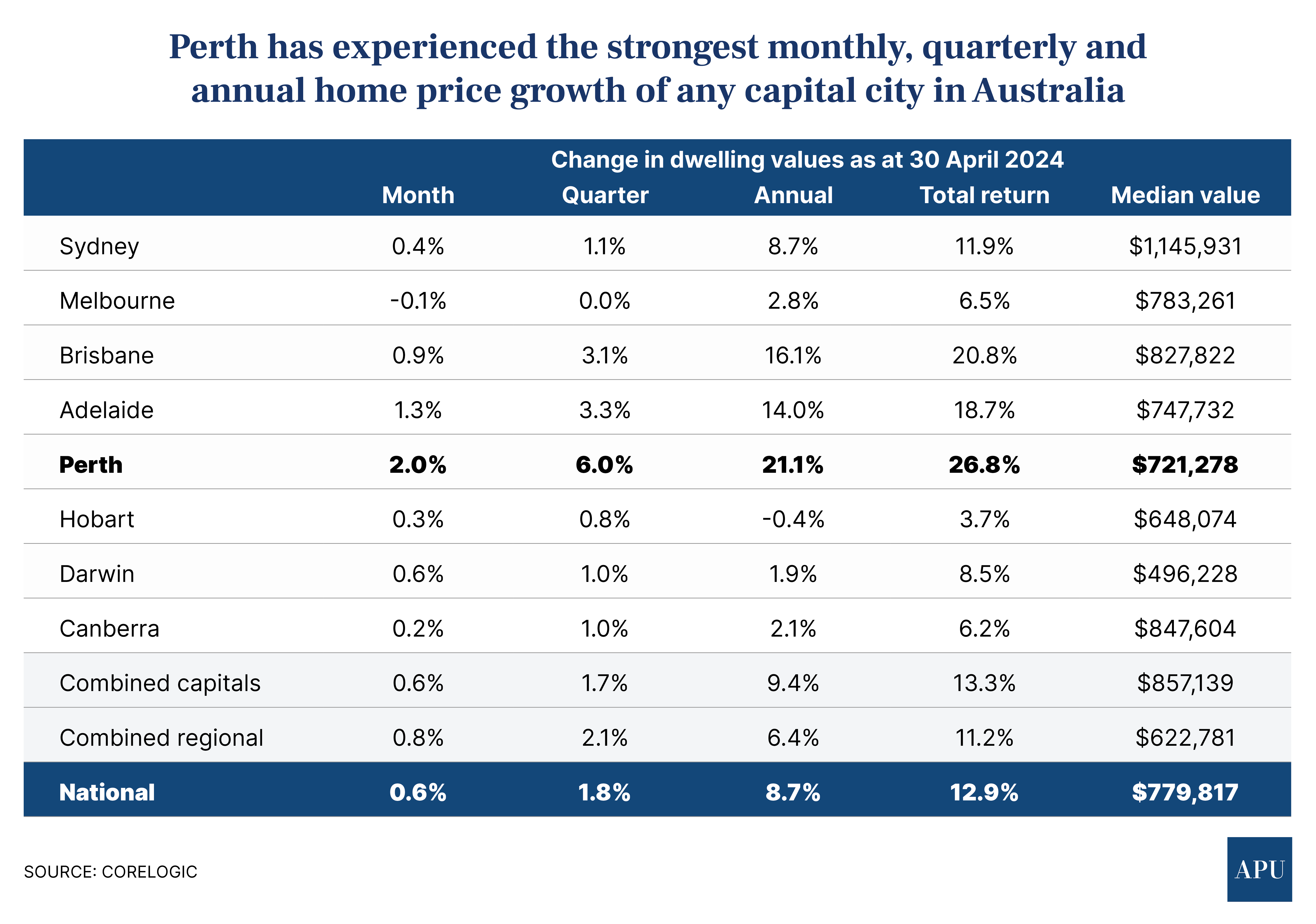Features > Property News & Insights > Housing Trends
Perth’s land supply problem set to keep home prices high

KEY POINTS
- Perth is facing a chronic land supply issue, with a shortage of blocks on which to construct new homes
- While the price of new lots for housing has soared, there are 70% fewer shovel-ready blocks than last year
- The average price of a new vacant lot in Perth is also at its highest point since the mining boom in March 2008
Already reeling from a housing crisis that has sent home prices and rents soaring, Perth is now facing a new challenge.
The West Australian capital is running out of shovel-ready land on which to build new houses and apartments.
According to the Urban Development Institute of Australia’s (UDIA) WA branch, just 617 lots of land were on the market on March 31st this year.
The situation has deteriorated since then, with the Real Estate Institute of Western Australia (REIWA) reporting that as of May 19th, just 488 blocks of land were listed for sale.
Demand high, supply constrained
The national housing crisis is probably most acute in Perth.
The city is experiencing a population boom, driven by significant overseas and interstate migration.
A record 95,000 people moved to Western Australia last year, and the REIWA says the current rental vacancy is just 0.5%.
As for home prices, CoreLogic’s latest figures say values have risen an astounding 21.1% in Perth over the year to April 30th, 2024—the largest jump of any capital city and nearly three times the rate of the national increase in home values.

Helping to drive up prices has been strong local and interstate investor demand for properties, coupled with slow construction rates of new homes.
That slow pace of bringing new homes online is being complicated by the fact that as demand has soared, the actual number of available land plots on which to build has dropped to its lowest level since 2006.
UDIA WA’s data shows there was a 30% increase in the number of lots sold during the March quarter.
However, as of March 31st, the actual number of available blocks of land was 34.5% lower than the previous quarter and 70% lower than the same time last year.
“This is the result of years of systemic failure in strategic planning to ensure we have a sustainable forward pipeline of housing supply,” says UDIA WA chief executive Tanya Steinbeck.
“Developers in greenfield areas simply cannot bring new development stages on fast enough to meet demand, and this is now having a significant impact on prices, with lot prices up 15% over the last 12 months and 5.2% just in the first three months of 2024.”
UDIA says the average plot of land in Perth now costs $279,974—the most expensive block in the WA capital since the height of the mining boom in March 2008.
What’s to be done?
The Urban Development Institute of Australia says obstacles to bringing more land to the market to meet demand include a lack of funding and coordination of essential infrastructure by the WA state government and local authorities and “unnecessary red and green tape.”
“While the recent (WA) State Budget had a focus on social and affordable housing,” UDIA WA chief executive Tanya Steinbeck says, “we must look at how we can deliver more housing right across the continuum.”
She points out that the government needs to do more to support builders and developers, as “the private industry in WA delivers around 96 per cent of homes to the market.”
The takeaway
UDIA WA is currently forecasting a shortfall of about 30,000 homes in Perth over the next five years.
Oxford Economics recently predicted that Perth will continue to remain Australia's top-performing capital city for home price growth for at least the next three years.
The forecaster believes median house prices in the city will rise another 12.9% this year, while house and unit prices are set to grow 9% per annum over the three years to June 2027.
Given the shortage of new land available for development in the West Australian capital, those forecasts could now prove to be on the conservative side.
Stay Up to Date
with the Latest Australian Property News, Insights & Education.




.png?width=292&height=292&name=Copy%20Link%20(1).png)
 SIGN UP FOR FREE NEWSLETTER
SIGN UP FOR FREE NEWSLETTER








.jpg?width=1920&height=1080&name=Warning%2c%20You%20Might%20Be%20Facing%20Higher%20Taxes%20Soon%20(1).jpg)





.png?width=1920&height=1080&name=Rate%20Drops%20Signal%20BIGGEST%20Property%20Boom%20in%20DECADES%20(1).png)

.jpg?width=1920&height=1080&name=Labor%20vs%20Liberal%20These%20Housing%20Policies%20Could%20Change%20the%20Property%20Market%20Forever%20(1).jpg)
.jpg?width=1920&height=1080&name=QLD%20Slashes%20Stamp%20Duty%20Big%20News%20for%20Investors%20%26%20Home%20Buyers%20(1).jpg)
.jpg?width=1920&height=1080&name=Trump%20Just%20Slapped%20Tariffs%20%E2%80%93%20Here%E2%80%99s%20What%20It%20Means%20for%20Australia%20(1).jpg)
.jpg?width=1920&height=1080&name=Federal%20Budget%202025%20More%20Debt%2c%20No%20Housing%20%E2%80%93%20Here%E2%80%99s%20What%20You%20Need%20to%20Know%20(1).jpg)
.jpg?width=1920&height=1080&name=Australias%20Housing%20Crisis%20is%20about%20to%20get%20MUCH%20Worse%20(New%20Data%20Warns).jpg)
%20(1).jpg?width=1920&height=1080&name=Australias%20RENTAL%20CRISIS%20Hits%20ROCK%20BOTTOM!%20(2025%20Update)%20(1).jpg)
%20(1).png?width=1920&height=1080&name=Is%20Adelaide%20Still%20a%20Good%20Property%20Investment%20(2025%20UPDATE)%20(1).png)
.jpg?width=1920&height=1080&name=RBA%20Shocks%20with%20Rate%20Cuts!%20What%E2%80%99s%20Next%20for%20Property%20Investors%20(1).jpg)
%20(1).jpg?width=1920&height=1080&name=I%20Predict%20The%20Feb%20Rate%20Cut%20(My%20Price%20Growth%20Prediction)%20(1).jpg)
.png?width=1920&height=1080&name=Why%20Property%20Prices%20Will%20Rise%20in%202025%20Market%20Predictions%20(1).png)
.jpg?width=1920&height=1080&name=Why%20Investors%20Are%20Choosing%20Apartments%20Over%20Houses%202%20(1).jpg)
.jpg?width=1920&height=1080&name=Why%20Rate%20Cuts%20Will%20Trigger%20A%20Property%20Boom%20(1).jpg)
.jpg?width=1920&height=1080&name=Retire%20On%202Million%20With%20One%20Property%20(Using%20SMSF).jpg)
.jpg?width=1920&height=1080&name=4%20Reasons%20Why%20You%20Should%20Invest%20in%20Melbourne%20Now%20(1).jpg)
%20(1).jpg?width=1920&height=1080&name=Old%20Property%20vs%20New%20Property%20(Facts%20and%20Figures%20Revealed)%20(1).jpg)
%20(1).jpg?width=1920&height=1080&name=Will%20The%20New%20QLD%20Govt%20Create%20a%20Property%20Boom%20or%20Bust%20(My%20Prediction)%20(1).jpg)
%20Scott%20Kuru%20(1).jpg?width=1920&height=1080&name=Inflation%20Hits%20Three-Year%20Low%20(Will%20RBA%20Cut%20Rates%20Soon)%20Scott%20Kuru%20(1).jpg)
.jpg?width=1920&height=1080&name=How%20to%20Buy%20Investment%20Property%20Through%20SMSF_%20The%20Ultimate%20Guide%20(1).jpg)
.jpg?width=1920&height=1080&name=Victoria%20Slashes%20Stamp%20Duty%20Melbourne%20Set%20to%20Boom%20Scott%20Kuru%20(1).jpg)
.png?width=1571&height=861&name=Are%20Foreign%20Buyers%20Really%20Driving%20Up%20Australian%20Property%20Prices%20(1).png)
.jpg?width=1920&height=1080&name=The%20Single%20Factor%20That%20Predicts%20Property%20Growth%20Regions%20(1).jpg)
%20Scott%20Kuru%20(1).jpg?width=1920&height=1080&name=My%20Prediction%20On%20Rates%20%26%20Negative%20Gearing%20(Market%20Crash)%20Scott%20Kuru%20(1).jpg)

-1.png?width=1920&height=1080&name=Major%20Banks%20Cut%20Rates%20Will%20RBA%20Follow%20Suit%20(Sept%20Rate%20Update)-1.png)
%20Scott%20Kuru-1.png?width=1920&height=1080&name=Rate%20Cut%20Coming%20What%20New%20Zealands%20Move%20Means%20for%20Australia%20(Sept%20Prediction)%20Scott%20Kuru-1.png)
%20(1).jpg?width=1920&height=1080&name=Buy%20when%20the%20interest%20rates%20are%20high!%20(Why%20you%20must%20buy%20now!)%20(1).jpg)
.jpg?width=1920&height=1080&name=Carms_Revised%20Taxes%20Due%20Aug%209%20YT%20Thumbnail02%20(1).jpg)
.jpg?width=1920&height=1080&name=Carms_Too%20Little%20Too%20Late%20Aug%207%20YT%20Thumbnail01%20(1).jpg)









.jpg?width=1920&height=1080&name=Carms_Rate%20Drop%20In%20July%20Jun%2010%20YT%20Thumbnail02%20(1).jpg)
.jpg?width=1920&height=1080&name=Carms_Own%20a%20Property%20V6%20Jun%205_YT%20Thumbnail%20(1).jpg)









.png?width=1920&height=1080&name=Artboard%201%20(3).png)






.jpg?width=1920&height=1080&name=YT%20thumbnail%20%20(1).jpg)

